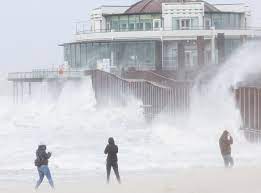After Storm Eunice took over 1 million houses off the grid on Friday, more than 200,000 British homes were still without power early on Saturday, according to a body representing electrical networks.
Three people were killed and considerable disruption was caused by the severe Atlantic storm, which brought record-breaking gusts of up to 122 miles per hour (196 kilometers per hour) to Britain. In Ireland, Belgium, and the Netherlands, at least six more deaths have been reported.
According to the Energy Networks Association, its members have restored 1.2 million consumers as of 0730 GMT, but over 226,000 remained without power, largely in southern England but also in the east and south Wales.
“That number is steadily decreasing, and engineers are working around the clock to reconnect people,” said Ross Easton, the industry body’s director of communications, to the BBC.
When a storm slammed northeast England and eastern Scotland in November, about 1 million homes lost electricity.
While the vast majority of homes were restored to power within 48 hours, more than 3,000 households were without electricity for a week or longer, forcing the government to urge a review of utility companies’ preparations.
Previous News
As the UK braces for 90 mph winds, residents are advised to stay at home.
The second severe storm this week triggered warnings of heavy winds and flying debris over northern Europe, prompting millions of people in the United Kingdom to cancel travel plans and stay home on Friday.
Storm Eunice, also known as Storm Zeynep in Germany, is expected to produce severe disruption and dangerous conditions, with gusts of up to 90 miles per hour in extremely exposed coastal locations, according to the UK weather service.
Authorities in the United Kingdom took the uncommon step of issuing “red” warnings for sections of southwest England between 7 a.m. and noon, and for southeast England and London between 10 a.m. and 3 p.m. From 5 a.m. until 9 p.m., a lower level amber warning for gusts up to 80 mph is in effect across England.
Eunice is Europe’s second named storm in two days, with the first killing at least five people in Germany and Poland. The storms were blamed on an exceptionally powerful jet stream across the eastern Atlantic Ocean, with gusts nearing 200 mph at high altitudes, according to Peter Inness, a meteorologist at the University of Reading in England.
“A strong jet stream like this can work as a storm assembly line, producing a new storm every day or two,” Inness explained. “In the recent past, there have been numerous occasions when two or more destructive storms moved across the United Kingdom and other areas of Europe in the space of a few days.
Eunice was already wreaking havoc on transport across southern England and Wales before the expected high winds arrived, with many train services disrupted and countless flights canceled. The London Eye, Legoland, and Warwick Castle were among the tourist attractions in England that shuttered ahead of the storm.
“I advise all Londoners to stay at home, avoid taking risks, and only go if absolutely necessary,” stated Mayor Sadiq Khan.
A meeting of the UK government’s COBRA emergency committee will be held to examine the storm. Home Office Minister Damian Hinds told Sky News that the Army is on “high readiness stand-by” to respond if needed.
Another indicator of life-threatening weather conditions is the Environment Agency’s issuance of ten extreme flood warnings.
“Storm Eunice will bring severe gusts in what might be one of the most impactful storms to batter southern and central regions of the United Kingdom in a few years,” said Paul Gundersen, the Met Office’s chief meteorologist. “The red warning regions represent a substantial risk of life due to exceptionally strong winds that could cause structural damage and flying debris.”
On Friday afternoon, the storm is predicted to reach northern Germany, and then move eastward overnight. On Friday, a flood warning was issued for Germany’s North Sea coast.
Meteorologists warned that Friday’s storm might do greater damage than the previous weather system, which caused at least three deaths, toppled trees, and destroyed roofs and railroad tracks, among other things.
As Eunice approached the low-lying Netherlands, the Dutch meteorology institute issued its strongest warning, code red, for coastal areas and code orange for much of the country. From 2 p.m. (1300 GMT), the country’s rail system will be shut down, airline KLM has canceled hundreds of flights, and Amsterdam’s Schiphol Airport will be shut.
Authorities placed sand walls around beach bars on Scheveningen beach in The Hague to shelter businesses from the wind, while dozens of surfers risked the weather in pursuit of waves whipped up by the storm.
Because of the storm, the Dutch soccer association has canceled all professional and amateur matches scheduled for Friday.
Storm Eunice has sparked fears because it has the ability to produce a “sting jet,” a localized area of high winds that might reach 100 mph.
According to the Met Office, one example of such a phenomenon happened during the Great Storm of 1987, which killed 18 people and knocked down 15 million trees across the United Kingdom.
“Eunice appears to have the potential to create a ‘sting jet,’ a limited, focused region of extremely strong winds embedded inside a broader area of strong winds that lasts only a few hours,” said Inness.
Passengers are being advised to avoid traveling on Friday by train companies across the United Kingdom.
The weather has slowed the rate at which planes are allowed to land at London’s Heathrow Airport, according to British Airways.
“High winds and bad weather may create last-minute delays,” the airline added, “but we will do everything we can to minimize any disturbance.”
High-sided cars and other “vulnerable” vehicles, such as caravans and motorcycles, should avoid bridges and viaducts, according to the federal transportation department.
Highways England’s head of road safety, Jeremy Phillips, advised travelers to “plan your route and take extra caution, giving additional time for your journey.”
“In the event of sustained high winds, we may need to close bridges to traffic for a period of time,” he added. “Please be vigilant for closure alerts and follow designated diversion routes.”
While once-in-a-decade storms like Eunice are expected to hit the British Isles in the future, there is no strong evidence that they will become more common or powerful in terms of wind speeds, according to Richard Allan, a professor of climate science at the University of Reading.
“However, if human activity continues to heat the earth, flooding from coastal storm surges and extended deluges will become more severe when these rare, explosive storms hit us in a warmer future,” he warned.

















